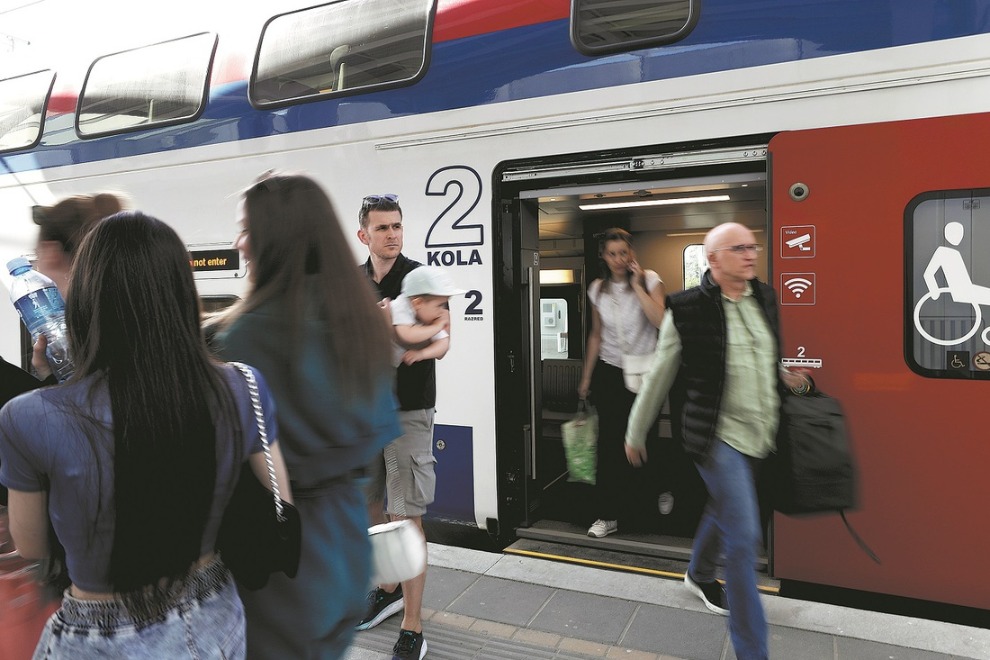
Passengers disembark from a train from Belgrade at Novi Sad Train Station in Novi Sad, Serbia, April 29.Li Ying/Xinhua News Agency
The history of the railway that connects Belgrade, the capital of Serbia, and Budapest, the capital of Hungary, dates back to 1883. At the time, the Orient Express ran between Paris and what is now known as Istanbul at an average speed of about 40 kilometers per hour.
More than 140 years later, the 342km high-speed railway linking the capital will run at speeds of up to 200km/h and, once completed, will reduce journey times from the current eight hours to three hours.
In Serbia, the 80km Belgrade-Novi Sad railway line opened on March 19, 2022, making it easier for people to move around and introducing a new commuting lifestyle.
According to China Railway International, more than 7 million passengers have traveled so far.
An average of 62 passenger trains operate each day, with a maximum daily passenger capacity of 15,059.
“Safe, efficient, convenient and comfortable high-speed rail creates a better travel experience for passengers and is widely supported by people along the line.Passenger travel volume continues to increase significantly, and train occupancy “has been maintained at a relatively high level,” the company said.
“This route will shorten the travel time between the two cities, allowing more people to start a new commuting lifestyle between the two cities.”
Railways facilitate the movement of people, freight, capital, and information and drive the development of commercial and tourism industries.
According to the company, the number of passengers visiting historical and cultural sites along the line is increasing, which creates more employment opportunities, provides development opportunities for more businesses and improves the socio-economic status of the region. Growth is said to be greatly accelerated.
Aleksandra Radovanovic, 27, lives in Belgrade and works in Novi Sad. The operation of the Belgrade-Novi Sad rail section has reduced her commuting time from 90 minutes to about 30 minutes.
Milan Banovic, a Serbian engineer who works for the Hungarian-Serbia Railway, currently commutes to work on this line every day.
“We have brought revolutionary changes. With high-speed trains running at 200km/h, the difference is incomparable. People are happy, train occupancy is high, and passenger numbers continue to rise. ” Banovich said.
Serbian Railways engineer Marko Jeremić said the ticket prices are affordable.
He said that cooperation with China Railway International in high-speed railways has enabled Serbia to become the railway leader in the Western Balkans.
“This is how we became the leader, because none of our neighboring countries like Croatia, Hungary or Bulgaria have high-speed lines exceeding 160 km/h,” he said.
Laying of the remaining 108 km of the line between Novi Sad and Subotica, between Novi Sad and Subotica, was completed last month, in preparation for the line's operation in Serbia by the end of this year.
The 342 km Serbo-Hungarian Railway is an important Belt and Road Initiative project in Europe. Once completed, the Serbian section of the railway will have a total length of 183 km and a maximum design speed of 200 km/h. The Hungarian section is 159km long and has a top speed of 160km/h.
The Serbian section is expected to be operational by the end of this year. The Hungarian section is under construction. Once completed, travel time between Belgrade and Budapest will be reduced from eight hours to approximately three hours.
The railway is a flagship cooperation project between China and Central and Eastern European countries, and is the first project to align China's railway technology and equipment with the European Union's technical specifications for railway connections.
Xinhua News Agency contributed to this article.



